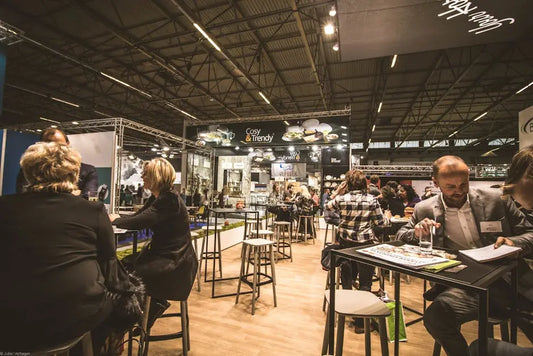Setting up a Waveline Display can seem daunting, especially if you’re striving for that professional look. Worry not! With a few expert tips, you’ll be able to showcase your brand with style and ease. Whether you’re a trade show novice or a seasoned veteran, these handy insights will help you maximize your display’s impact.
1. Choose the Right Size and Shape
Before you start setting up, make sure you’ve picked the Waveline Display that best fits your space and needs. Consider the layout and size of your booth. Choose a shape that complements your brand’s message and stands out in the crowd. For example, the Waveline Seahorse-A Display offers an eye-catching and sleek design that can give your booth that ‘wow’ factor. Flipping one module or panel around gives you the flexibility to alter the look and feel of your presentation dynamically.
2. Quality Graphics Are a Must
High-resolution, clear graphics on your Waveline Display can make a big difference in attracting attention. Invest in quality images and think about how your visuals tell the story of your brand. The Waveline Scallop-A Display for instance, uses dye-sublimated fabrics for high-resolution, fade-resistant graphics that slip onto frames with ease. Such elements not only enhance the visual appeal but also ensure longevity and repeated use, making them a worthy investment.
3. Simplify Your Message
Less is often more when it comes to trade show displays. Keep your text concise and impactful. Use bullet points or short sentences to communicate key messages effectively. This approach ensures that your intended audience grasps your message quickly, encouraging them to engage further with your display. Remember, the aim is to spark enough interest for attendees to approach and learn more about what you have to offer.
4. Incorporate Branding Elements
Ensure your brand logo is prominently displayed and that your brand colors are consistent. This strengthens brand recognition and makes your booth instantly identifiable. Leverage items like the Waveline Seahorse-B Display which allow for single or double-sided graphics, offering flexibility in how you present your branding elements.
5. Strategic Lighting
Good lighting can enhance your display’s appearance and draw visitors in. Use LED lights for an even, bright finish that highlights your graphics and key areas of interest. Strategic lighting not only visually enhances your space but can also guide visitor attention to particular aspects of your booth, such as new products or important information. Ensuring your display is well-lit can help your message shine, even in a crowded exhibition hall.
6. Utilize Accessories Wisely
Add depth and interest with accessories like literature racks or promotional counters. They can serve as informational touchpoints, but avoid cluttering your display. Effective use of accessories can transform your exhibit into an interactive space where visitors actively engage with your content, picking up information at their own pace. Balance is key—too many items can overwhelm, while well-placed elements can guide a visitor’s journey through your booth.
7. Ensure Easy Setup and Takedown
Choose a display that’s easy to set up and dismantle. This saves you time and effort, allowing you to focus more on engaging with attendees. The modular nature of many Waveline Displays, for instance, employs lightweight aluminum frames with push-pin connectors, ensuring that the assembly process remains straightforward and hassle-free. Such thoughtful design considerations mean you can divert your energy towards marketing while maintaining the flexibility for quick adjustments if necessary.
8. Consider Portability
A portable display makes transportation to and from events a breeze. Look for lightweight options that don’t compromise on quality or visual appeal. Waveline Displays are an ideal choice here, given their lightweight construction without sacrificing durability. The ease of portability ensures less hassle between events, freeing you to focus more on creative aspects such as updating graphics or planning your booth layout.
9. Use 3D Elements
Incorporate three-dimensional elements like pop-up features or integrated shelves to make your display more dynamic and visually interesting. Not only do these elements capture attention quickly, but they also invite attendees to engage more deeply with the material presented. By offering layers of interaction, 3D designs invite curiosity, compelling visitors to explore and familiarize themselves with your brand’s offerings at a more intimate level.
10. Plan for Interactivity
Encourage attendee interaction with touch screens or virtual tours. Interactive elements can engage visitors more effectively than static displays alone. These tools provide a memorable experience and allow participants to engage with your content at a personalized pace, fostering a deeper connection between your brand and the potential customer. Consider using virtual reality or augmented reality elements to offer unique perspectives on your products or services.
11. Be Consistent with Your Theme
Make sure that everything from your graphics to your accessories aligns with a cohesive theme or marketing message. This reinforces your brand story and engages your audience. Cohesion in the presentation makes it easier for your audience to understand and remember your brand message. Themed displays not only offer a unified brand presence but also deepen the impact of your story, ensuring that it resonates long after the initial interaction.
12. Test Your Design Setup
Before the big day, set up your display in a trial run. This helps iron out any issues and ensures you are fully prepared when it’s time to impress at the event. Early testing allows you to identify potential pitfalls and correct them proactively, ensuring a seamless execution on the exhibition day. This dry run serves as a dress rehearsal where logistics can be streamlined, ensuring that nothing detracts from your main goal—effectively engaging visitors.



